Equitable and Statutory Remedies for Minority Shareholders in Corporate Law
VerifiedAdded on 2023/01/11
|10
|2863
|76
AI Summary
This article discusses the equitable and statutory remedies available to minority shareholders in corporate law when faced with oppressive conduct by majority shareholders. It explores the exceptions to the Foss v Harbottle rule and the potential outcomes of these remedies. The case of Tim, a minority shareholder facing bullying and potential expulsion by his majority shareholder brothers, is used as an example to illustrate the application of these remedies.
Contribute Materials
Your contribution can guide someone’s learning journey. Share your
documents today.
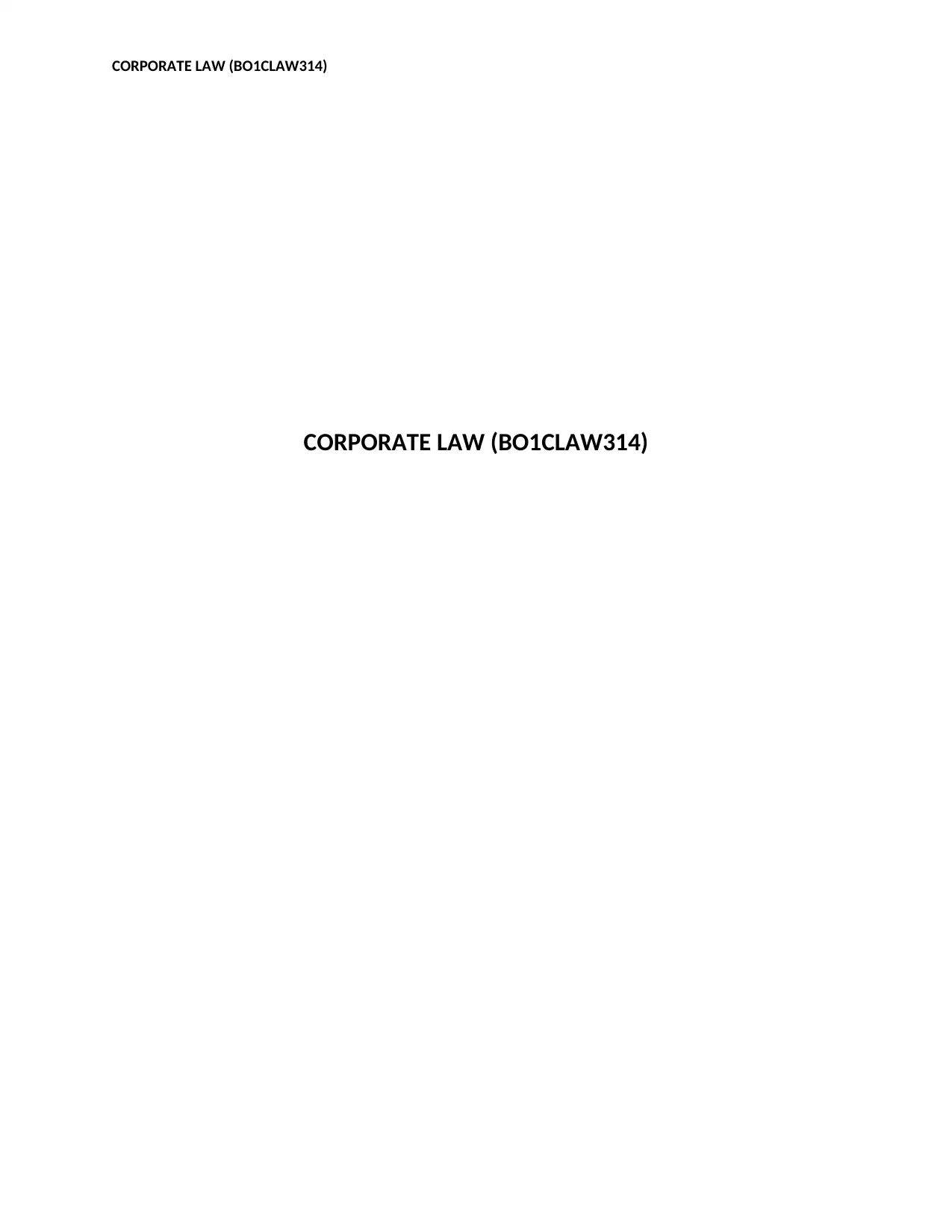
CORPORATE LAW (BO1CLAW314)
CORPORATE LAW (BO1CLAW314)
CORPORATE LAW (BO1CLAW314)
Secure Best Marks with AI Grader
Need help grading? Try our AI Grader for instant feedback on your assignments.
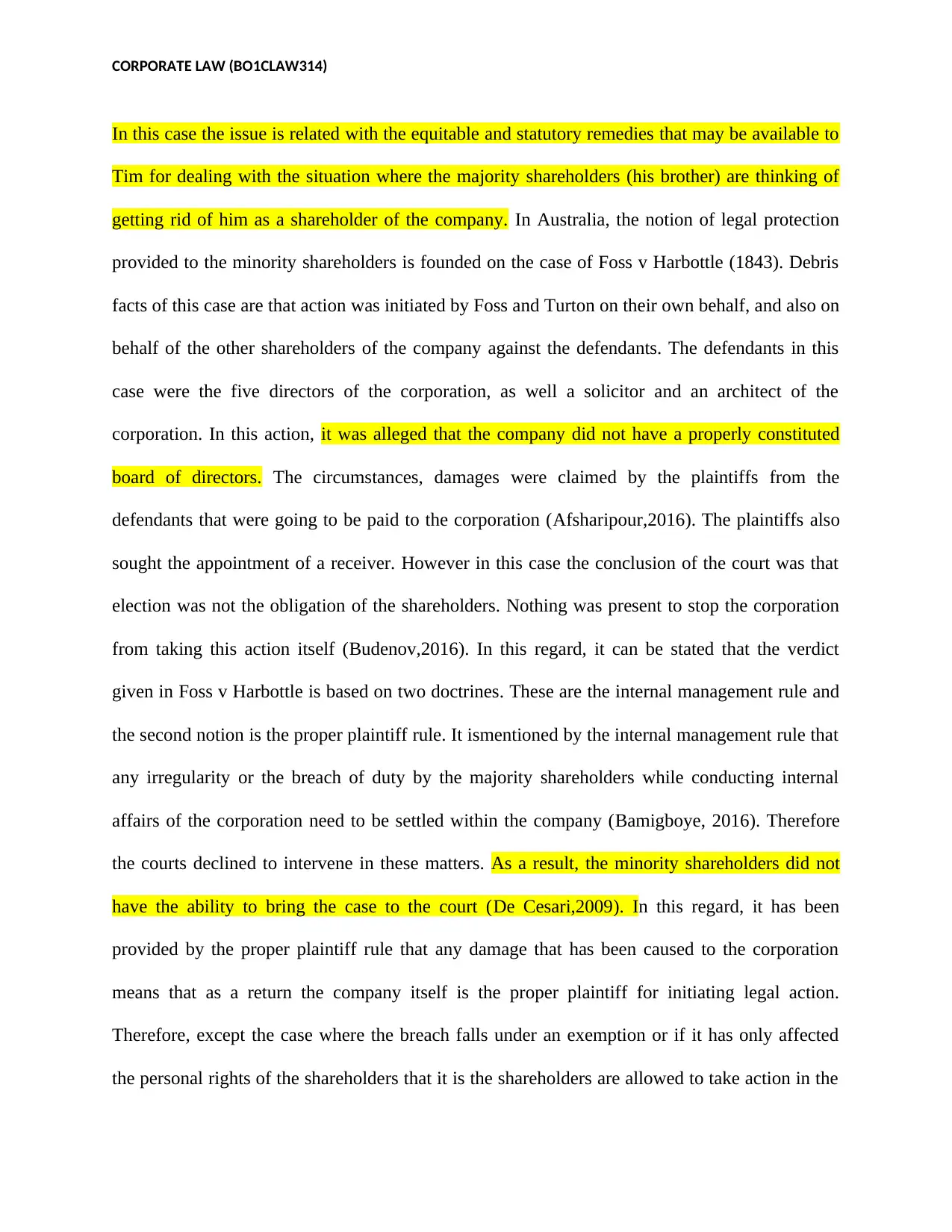
CORPORATE LAW (BO1CLAW314)
In this case the issue is related with the equitable and statutory remedies that may be available to
Tim for dealing with the situation where the majority shareholders (his brother) are thinking of
getting rid of him as a shareholder of the company. In Australia, the notion of legal protection
provided to the minority shareholders is founded on the case of Foss v Harbottle (1843). Debris
facts of this case are that action was initiated by Foss and Turton on their own behalf, and also on
behalf of the other shareholders of the company against the defendants. The defendants in this
case were the five directors of the corporation, as well a solicitor and an architect of the
corporation. In this action, it was alleged that the company did not have a properly constituted
board of directors. The circumstances, damages were claimed by the plaintiffs from the
defendants that were going to be paid to the corporation (Afsharipour,2016). The plaintiffs also
sought the appointment of a receiver. However in this case the conclusion of the court was that
election was not the obligation of the shareholders. Nothing was present to stop the corporation
from taking this action itself (Budenov,2016). In this regard, it can be stated that the verdict
given in Foss v Harbottle is based on two doctrines. These are the internal management rule and
the second notion is the proper plaintiff rule. It ismentioned by the internal management rule that
any irregularity or the breach of duty by the majority shareholders while conducting internal
affairs of the corporation need to be settled within the company (Bamigboye, 2016). Therefore
the courts declined to intervene in these matters. As a result, the minority shareholders did not
have the ability to bring the case to the court (De Cesari,2009). In this regard, it has been
provided by the proper plaintiff rule that any damage that has been caused to the corporation
means that as a return the company itself is the proper plaintiff for initiating legal action.
Therefore, except the case where the breach falls under an exemption or if it has only affected
the personal rights of the shareholders that it is the shareholders are allowed to take action in the
In this case the issue is related with the equitable and statutory remedies that may be available to
Tim for dealing with the situation where the majority shareholders (his brother) are thinking of
getting rid of him as a shareholder of the company. In Australia, the notion of legal protection
provided to the minority shareholders is founded on the case of Foss v Harbottle (1843). Debris
facts of this case are that action was initiated by Foss and Turton on their own behalf, and also on
behalf of the other shareholders of the company against the defendants. The defendants in this
case were the five directors of the corporation, as well a solicitor and an architect of the
corporation. In this action, it was alleged that the company did not have a properly constituted
board of directors. The circumstances, damages were claimed by the plaintiffs from the
defendants that were going to be paid to the corporation (Afsharipour,2016). The plaintiffs also
sought the appointment of a receiver. However in this case the conclusion of the court was that
election was not the obligation of the shareholders. Nothing was present to stop the corporation
from taking this action itself (Budenov,2016). In this regard, it can be stated that the verdict
given in Foss v Harbottle is based on two doctrines. These are the internal management rule and
the second notion is the proper plaintiff rule. It ismentioned by the internal management rule that
any irregularity or the breach of duty by the majority shareholders while conducting internal
affairs of the corporation need to be settled within the company (Bamigboye, 2016). Therefore
the courts declined to intervene in these matters. As a result, the minority shareholders did not
have the ability to bring the case to the court (De Cesari,2009). In this regard, it has been
provided by the proper plaintiff rule that any damage that has been caused to the corporation
means that as a return the company itself is the proper plaintiff for initiating legal action.
Therefore, except the case where the breach falls under an exemption or if it has only affected
the personal rights of the shareholders that it is the shareholders are allowed to take action in the
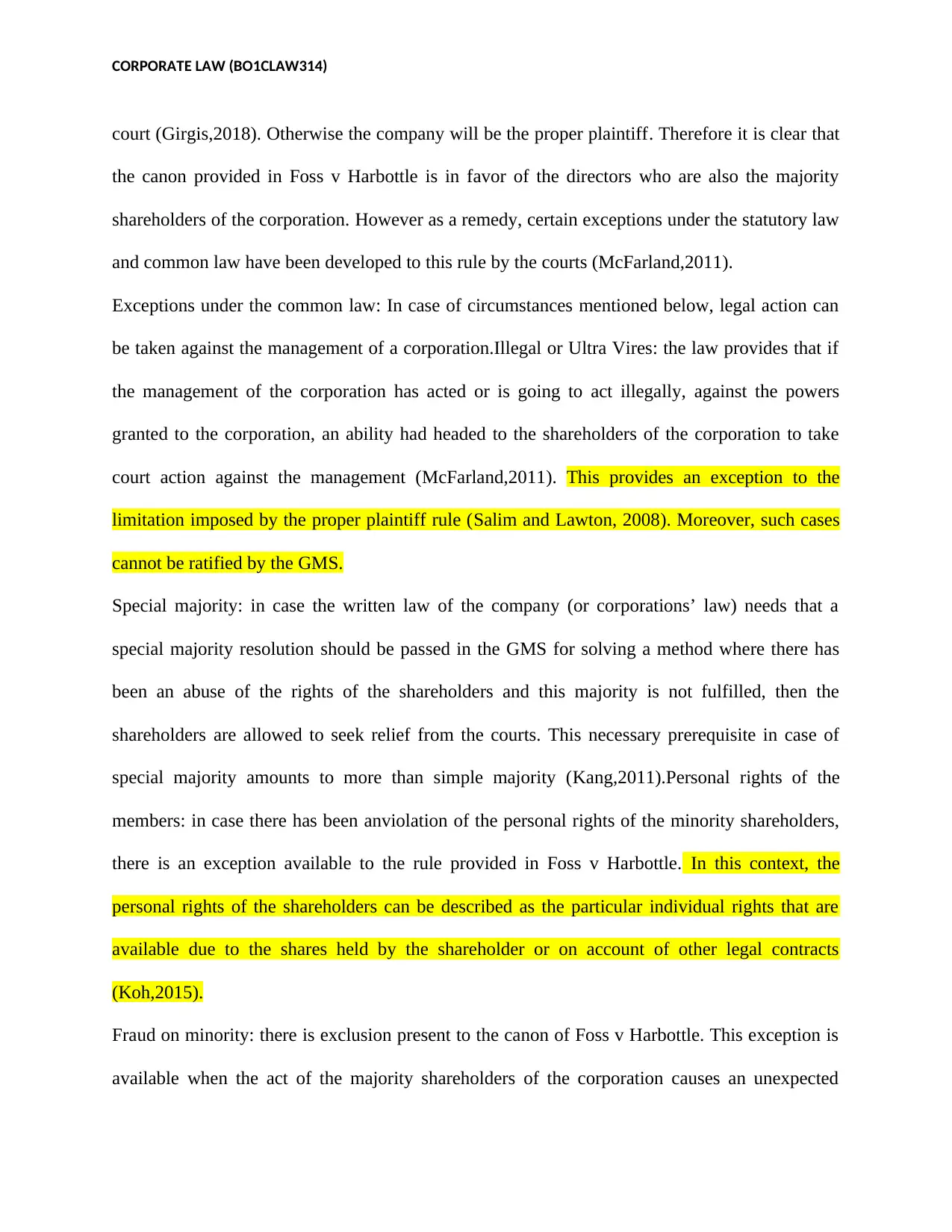
CORPORATE LAW (BO1CLAW314)
court (Girgis,2018). Otherwise the company will be the proper plaintiff. Therefore it is clear that
the canon provided in Foss v Harbottle is in favor of the directors who are also the majority
shareholders of the corporation. However as a remedy, certain exceptions under the statutory law
and common law have been developed to this rule by the courts (McFarland,2011).
Exceptions under the common law: In case of circumstances mentioned below, legal action can
be taken against the management of a corporation.Illegal or Ultra Vires: the law provides that if
the management of the corporation has acted or is going to act illegally, against the powers
granted to the corporation, an ability had headed to the shareholders of the corporation to take
court action against the management (McFarland,2011). This provides an exception to the
limitation imposed by the proper plaintiff rule (Salim and Lawton, 2008). Moreover, such cases
cannot be ratified by the GMS.
Special majority: in case the written law of the company (or corporations’ law) needs that a
special majority resolution should be passed in the GMS for solving a method where there has
been an abuse of the rights of the shareholders and this majority is not fulfilled, then the
shareholders are allowed to seek relief from the courts. This necessary prerequisite in case of
special majority amounts to more than simple majority (Kang,2011).Personal rights of the
members: in case there has been anviolation of the personal rights of the minority shareholders,
there is an exception available to the rule provided in Foss v Harbottle. In this context, the
personal rights of the shareholders can be described as the particular individual rights that are
available due to the shares held by the shareholder or on account of other legal contracts
(Koh,2015).
Fraud on minority: there is exclusion present to the canon of Foss v Harbottle. This exception is
available when the act of the majority shareholders of the corporation causes an unexpected
court (Girgis,2018). Otherwise the company will be the proper plaintiff. Therefore it is clear that
the canon provided in Foss v Harbottle is in favor of the directors who are also the majority
shareholders of the corporation. However as a remedy, certain exceptions under the statutory law
and common law have been developed to this rule by the courts (McFarland,2011).
Exceptions under the common law: In case of circumstances mentioned below, legal action can
be taken against the management of a corporation.Illegal or Ultra Vires: the law provides that if
the management of the corporation has acted or is going to act illegally, against the powers
granted to the corporation, an ability had headed to the shareholders of the corporation to take
court action against the management (McFarland,2011). This provides an exception to the
limitation imposed by the proper plaintiff rule (Salim and Lawton, 2008). Moreover, such cases
cannot be ratified by the GMS.
Special majority: in case the written law of the company (or corporations’ law) needs that a
special majority resolution should be passed in the GMS for solving a method where there has
been an abuse of the rights of the shareholders and this majority is not fulfilled, then the
shareholders are allowed to seek relief from the courts. This necessary prerequisite in case of
special majority amounts to more than simple majority (Kang,2011).Personal rights of the
members: in case there has been anviolation of the personal rights of the minority shareholders,
there is an exception available to the rule provided in Foss v Harbottle. In this context, the
personal rights of the shareholders can be described as the particular individual rights that are
available due to the shares held by the shareholder or on account of other legal contracts
(Koh,2015).
Fraud on minority: there is exclusion present to the canon of Foss v Harbottle. This exception is
available when the act of the majority shareholders of the corporation causes an unexpected
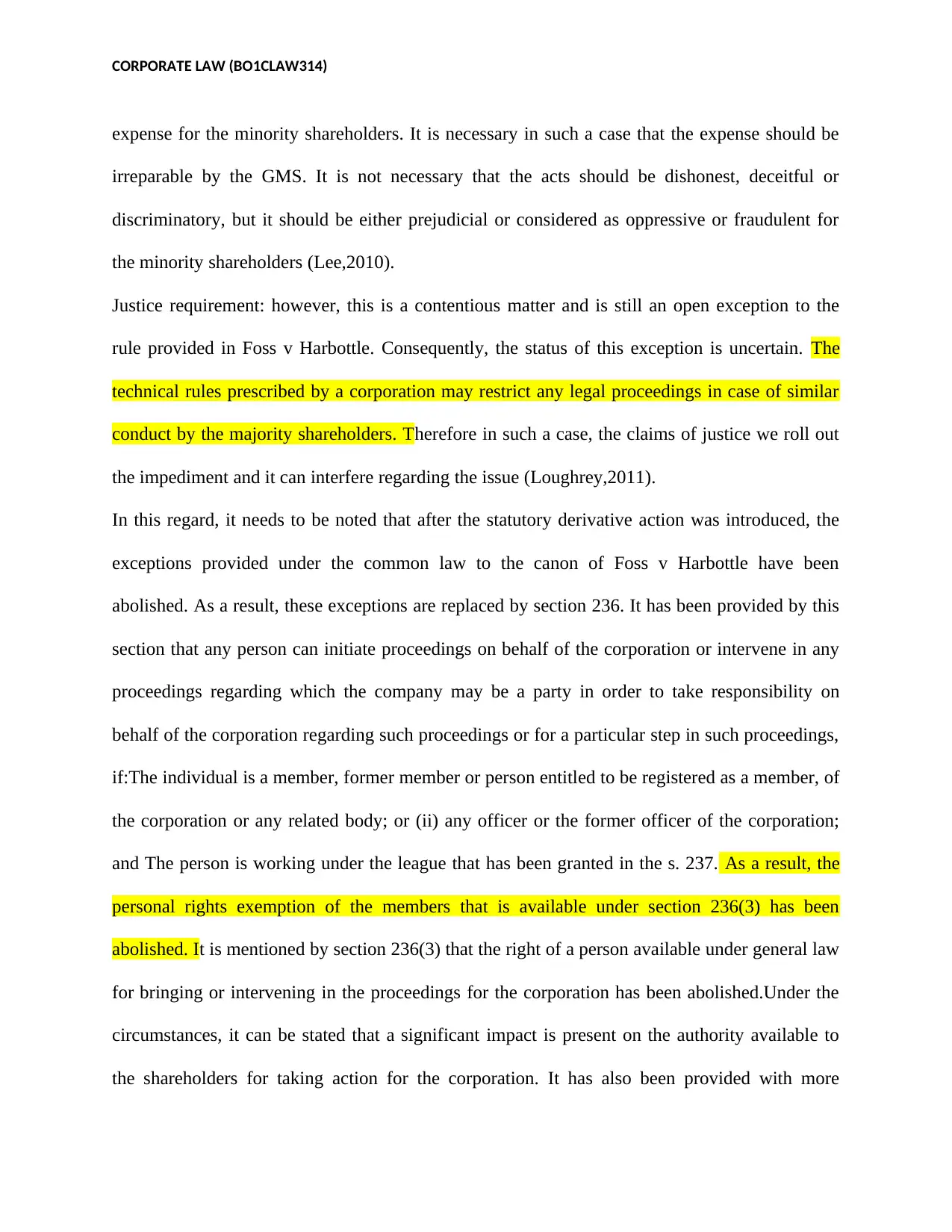
CORPORATE LAW (BO1CLAW314)
expense for the minority shareholders. It is necessary in such a case that the expense should be
irreparable by the GMS. It is not necessary that the acts should be dishonest, deceitful or
discriminatory, but it should be either prejudicial or considered as oppressive or fraudulent for
the minority shareholders (Lee,2010).
Justice requirement: however, this is a contentious matter and is still an open exception to the
rule provided in Foss v Harbottle. Consequently, the status of this exception is uncertain. The
technical rules prescribed by a corporation may restrict any legal proceedings in case of similar
conduct by the majority shareholders. Therefore in such a case, the claims of justice we roll out
the impediment and it can interfere regarding the issue (Loughrey,2011).
In this regard, it needs to be noted that after the statutory derivative action was introduced, the
exceptions provided under the common law to the canon of Foss v Harbottle have been
abolished. As a result, these exceptions are replaced by section 236. It has been provided by this
section that any person can initiate proceedings on behalf of the corporation or intervene in any
proceedings regarding which the company may be a party in order to take responsibility on
behalf of the corporation regarding such proceedings or for a particular step in such proceedings,
if:The individual is a member, former member or person entitled to be registered as a member, of
the corporation or any related body; or (ii) any officer or the former officer of the corporation;
and The person is working under the league that has been granted in the s. 237. As a result, the
personal rights exemption of the members that is available under section 236(3) has been
abolished. It is mentioned by section 236(3) that the right of a person available under general law
for bringing or intervening in the proceedings for the corporation has been abolished.Under the
circumstances, it can be stated that a significant impact is present on the authority available to
the shareholders for taking action for the corporation. It has also been provided with more
expense for the minority shareholders. It is necessary in such a case that the expense should be
irreparable by the GMS. It is not necessary that the acts should be dishonest, deceitful or
discriminatory, but it should be either prejudicial or considered as oppressive or fraudulent for
the minority shareholders (Lee,2010).
Justice requirement: however, this is a contentious matter and is still an open exception to the
rule provided in Foss v Harbottle. Consequently, the status of this exception is uncertain. The
technical rules prescribed by a corporation may restrict any legal proceedings in case of similar
conduct by the majority shareholders. Therefore in such a case, the claims of justice we roll out
the impediment and it can interfere regarding the issue (Loughrey,2011).
In this regard, it needs to be noted that after the statutory derivative action was introduced, the
exceptions provided under the common law to the canon of Foss v Harbottle have been
abolished. As a result, these exceptions are replaced by section 236. It has been provided by this
section that any person can initiate proceedings on behalf of the corporation or intervene in any
proceedings regarding which the company may be a party in order to take responsibility on
behalf of the corporation regarding such proceedings or for a particular step in such proceedings,
if:The individual is a member, former member or person entitled to be registered as a member, of
the corporation or any related body; or (ii) any officer or the former officer of the corporation;
and The person is working under the league that has been granted in the s. 237. As a result, the
personal rights exemption of the members that is available under section 236(3) has been
abolished. It is mentioned by section 236(3) that the right of a person available under general law
for bringing or intervening in the proceedings for the corporation has been abolished.Under the
circumstances, it can be stated that a significant impact is present on the authority available to
the shareholders for taking action for the corporation. It has also been provided with more
Secure Best Marks with AI Grader
Need help grading? Try our AI Grader for instant feedback on your assignments.
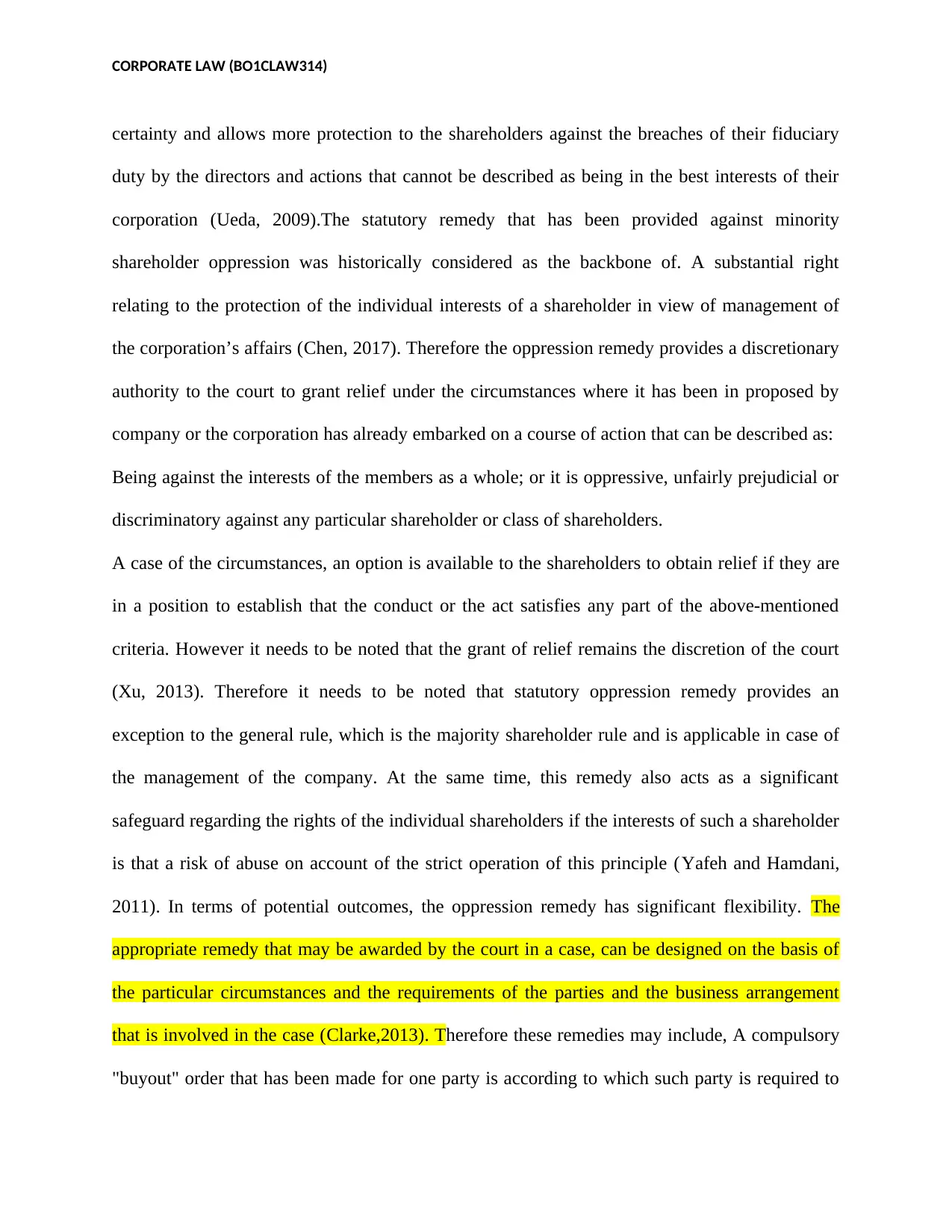
CORPORATE LAW (BO1CLAW314)
certainty and allows more protection to the shareholders against the breaches of their fiduciary
duty by the directors and actions that cannot be described as being in the best interests of their
corporation (Ueda, 2009).The statutory remedy that has been provided against minority
shareholder oppression was historically considered as the backbone of. A substantial right
relating to the protection of the individual interests of a shareholder in view of management of
the corporation’s affairs (Chen, 2017). Therefore the oppression remedy provides a discretionary
authority to the court to grant relief under the circumstances where it has been in proposed by
company or the corporation has already embarked on a course of action that can be described as:
Being against the interests of the members as a whole; or it is oppressive, unfairly prejudicial or
discriminatory against any particular shareholder or class of shareholders.
A case of the circumstances, an option is available to the shareholders to obtain relief if they are
in a position to establish that the conduct or the act satisfies any part of the above-mentioned
criteria. However it needs to be noted that the grant of relief remains the discretion of the court
(Xu, 2013). Therefore it needs to be noted that statutory oppression remedy provides an
exception to the general rule, which is the majority shareholder rule and is applicable in case of
the management of the company. At the same time, this remedy also acts as a significant
safeguard regarding the rights of the individual shareholders if the interests of such a shareholder
is that a risk of abuse on account of the strict operation of this principle (Yafeh and Hamdani,
2011). In terms of potential outcomes, the oppression remedy has significant flexibility. The
appropriate remedy that may be awarded by the court in a case, can be designed on the basis of
the particular circumstances and the requirements of the parties and the business arrangement
that is involved in the case (Clarke,2013). Therefore these remedies may include, A compulsory
"buyout" order that has been made for one party is according to which such party is required to
certainty and allows more protection to the shareholders against the breaches of their fiduciary
duty by the directors and actions that cannot be described as being in the best interests of their
corporation (Ueda, 2009).The statutory remedy that has been provided against minority
shareholder oppression was historically considered as the backbone of. A substantial right
relating to the protection of the individual interests of a shareholder in view of management of
the corporation’s affairs (Chen, 2017). Therefore the oppression remedy provides a discretionary
authority to the court to grant relief under the circumstances where it has been in proposed by
company or the corporation has already embarked on a course of action that can be described as:
Being against the interests of the members as a whole; or it is oppressive, unfairly prejudicial or
discriminatory against any particular shareholder or class of shareholders.
A case of the circumstances, an option is available to the shareholders to obtain relief if they are
in a position to establish that the conduct or the act satisfies any part of the above-mentioned
criteria. However it needs to be noted that the grant of relief remains the discretion of the court
(Xu, 2013). Therefore it needs to be noted that statutory oppression remedy provides an
exception to the general rule, which is the majority shareholder rule and is applicable in case of
the management of the company. At the same time, this remedy also acts as a significant
safeguard regarding the rights of the individual shareholders if the interests of such a shareholder
is that a risk of abuse on account of the strict operation of this principle (Yafeh and Hamdani,
2011). In terms of potential outcomes, the oppression remedy has significant flexibility. The
appropriate remedy that may be awarded by the court in a case, can be designed on the basis of
the particular circumstances and the requirements of the parties and the business arrangement
that is involved in the case (Clarke,2013). Therefore these remedies may include, A compulsory
"buyout" order that has been made for one party is according to which such party is required to
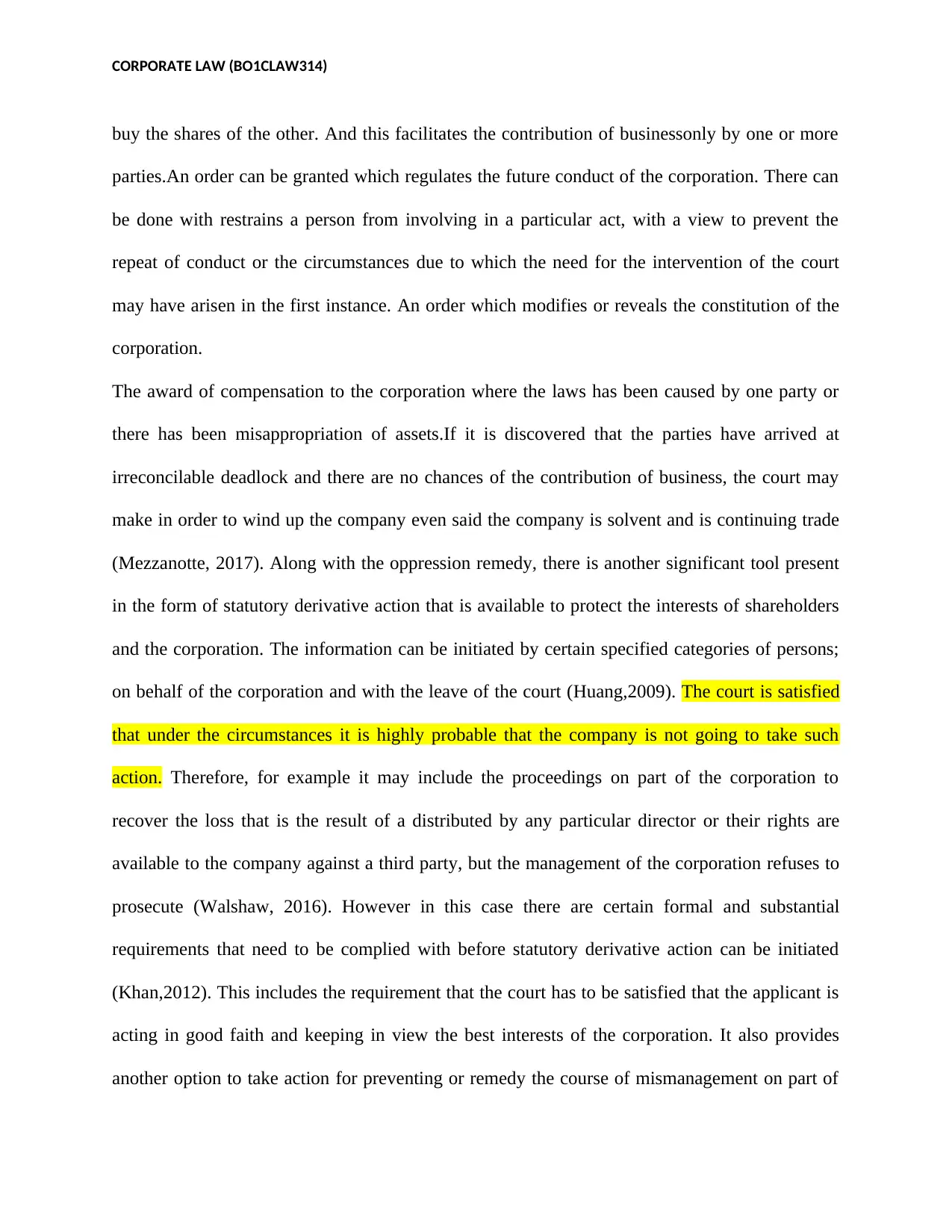
CORPORATE LAW (BO1CLAW314)
buy the shares of the other. And this facilitates the contribution of businessonly by one or more
parties.An order can be granted which regulates the future conduct of the corporation. There can
be done with restrains a person from involving in a particular act, with a view to prevent the
repeat of conduct or the circumstances due to which the need for the intervention of the court
may have arisen in the first instance. An order which modifies or reveals the constitution of the
corporation.
The award of compensation to the corporation where the laws has been caused by one party or
there has been misappropriation of assets.If it is discovered that the parties have arrived at
irreconcilable deadlock and there are no chances of the contribution of business, the court may
make in order to wind up the company even said the company is solvent and is continuing trade
(Mezzanotte, 2017). Along with the oppression remedy, there is another significant tool present
in the form of statutory derivative action that is available to protect the interests of shareholders
and the corporation. The information can be initiated by certain specified categories of persons;
on behalf of the corporation and with the leave of the court (Huang,2009). The court is satisfied
that under the circumstances it is highly probable that the company is not going to take such
action. Therefore, for example it may include the proceedings on part of the corporation to
recover the loss that is the result of a distributed by any particular director or their rights are
available to the company against a third party, but the management of the corporation refuses to
prosecute (Walshaw, 2016). However in this case there are certain formal and substantial
requirements that need to be complied with before statutory derivative action can be initiated
(Khan,2012). This includes the requirement that the court has to be satisfied that the applicant is
acting in good faith and keeping in view the best interests of the corporation. It also provides
another option to take action for preventing or remedy the course of mismanagement on part of
buy the shares of the other. And this facilitates the contribution of businessonly by one or more
parties.An order can be granted which regulates the future conduct of the corporation. There can
be done with restrains a person from involving in a particular act, with a view to prevent the
repeat of conduct or the circumstances due to which the need for the intervention of the court
may have arisen in the first instance. An order which modifies or reveals the constitution of the
corporation.
The award of compensation to the corporation where the laws has been caused by one party or
there has been misappropriation of assets.If it is discovered that the parties have arrived at
irreconcilable deadlock and there are no chances of the contribution of business, the court may
make in order to wind up the company even said the company is solvent and is continuing trade
(Mezzanotte, 2017). Along with the oppression remedy, there is another significant tool present
in the form of statutory derivative action that is available to protect the interests of shareholders
and the corporation. The information can be initiated by certain specified categories of persons;
on behalf of the corporation and with the leave of the court (Huang,2009). The court is satisfied
that under the circumstances it is highly probable that the company is not going to take such
action. Therefore, for example it may include the proceedings on part of the corporation to
recover the loss that is the result of a distributed by any particular director or their rights are
available to the company against a third party, but the management of the corporation refuses to
prosecute (Walshaw, 2016). However in this case there are certain formal and substantial
requirements that need to be complied with before statutory derivative action can be initiated
(Khan,2012). This includes the requirement that the court has to be satisfied that the applicant is
acting in good faith and keeping in view the best interests of the corporation. It also provides
another option to take action for preventing or remedy the course of mismanagement on part of
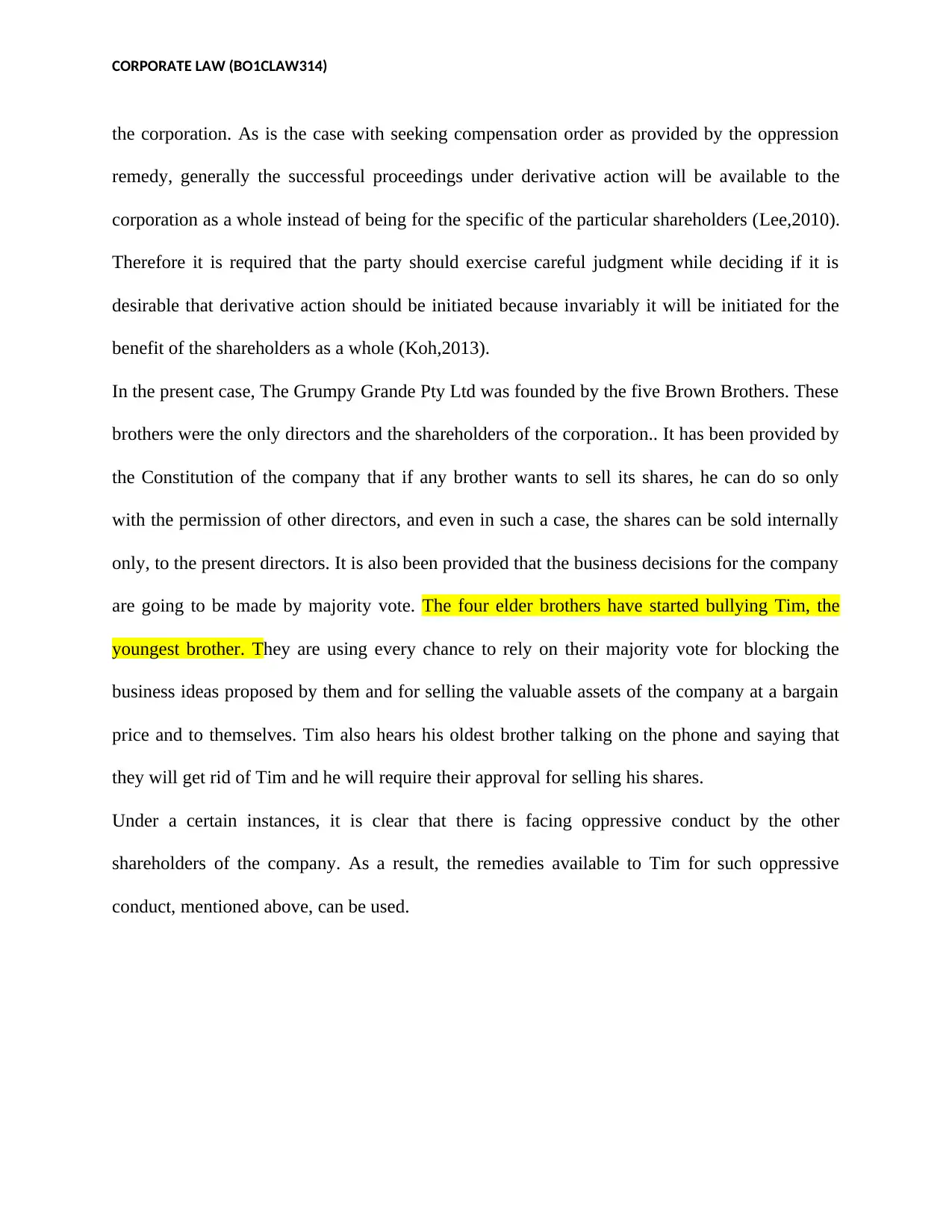
CORPORATE LAW (BO1CLAW314)
the corporation. As is the case with seeking compensation order as provided by the oppression
remedy, generally the successful proceedings under derivative action will be available to the
corporation as a whole instead of being for the specific of the particular shareholders (Lee,2010).
Therefore it is required that the party should exercise careful judgment while deciding if it is
desirable that derivative action should be initiated because invariably it will be initiated for the
benefit of the shareholders as a whole (Koh,2013).
In the present case, The Grumpy Grande Pty Ltd was founded by the five Brown Brothers. These
brothers were the only directors and the shareholders of the corporation.. It has been provided by
the Constitution of the company that if any brother wants to sell its shares, he can do so only
with the permission of other directors, and even in such a case, the shares can be sold internally
only, to the present directors. It is also been provided that the business decisions for the company
are going to be made by majority vote. The four elder brothers have started bullying Tim, the
youngest brother. They are using every chance to rely on their majority vote for blocking the
business ideas proposed by them and for selling the valuable assets of the company at a bargain
price and to themselves. Tim also hears his oldest brother talking on the phone and saying that
they will get rid of Tim and he will require their approval for selling his shares.
Under a certain instances, it is clear that there is facing oppressive conduct by the other
shareholders of the company. As a result, the remedies available to Tim for such oppressive
conduct, mentioned above, can be used.
the corporation. As is the case with seeking compensation order as provided by the oppression
remedy, generally the successful proceedings under derivative action will be available to the
corporation as a whole instead of being for the specific of the particular shareholders (Lee,2010).
Therefore it is required that the party should exercise careful judgment while deciding if it is
desirable that derivative action should be initiated because invariably it will be initiated for the
benefit of the shareholders as a whole (Koh,2013).
In the present case, The Grumpy Grande Pty Ltd was founded by the five Brown Brothers. These
brothers were the only directors and the shareholders of the corporation.. It has been provided by
the Constitution of the company that if any brother wants to sell its shares, he can do so only
with the permission of other directors, and even in such a case, the shares can be sold internally
only, to the present directors. It is also been provided that the business decisions for the company
are going to be made by majority vote. The four elder brothers have started bullying Tim, the
youngest brother. They are using every chance to rely on their majority vote for blocking the
business ideas proposed by them and for selling the valuable assets of the company at a bargain
price and to themselves. Tim also hears his oldest brother talking on the phone and saying that
they will get rid of Tim and he will require their approval for selling his shares.
Under a certain instances, it is clear that there is facing oppressive conduct by the other
shareholders of the company. As a result, the remedies available to Tim for such oppressive
conduct, mentioned above, can be used.
Paraphrase This Document
Need a fresh take? Get an instant paraphrase of this document with our AI Paraphraser
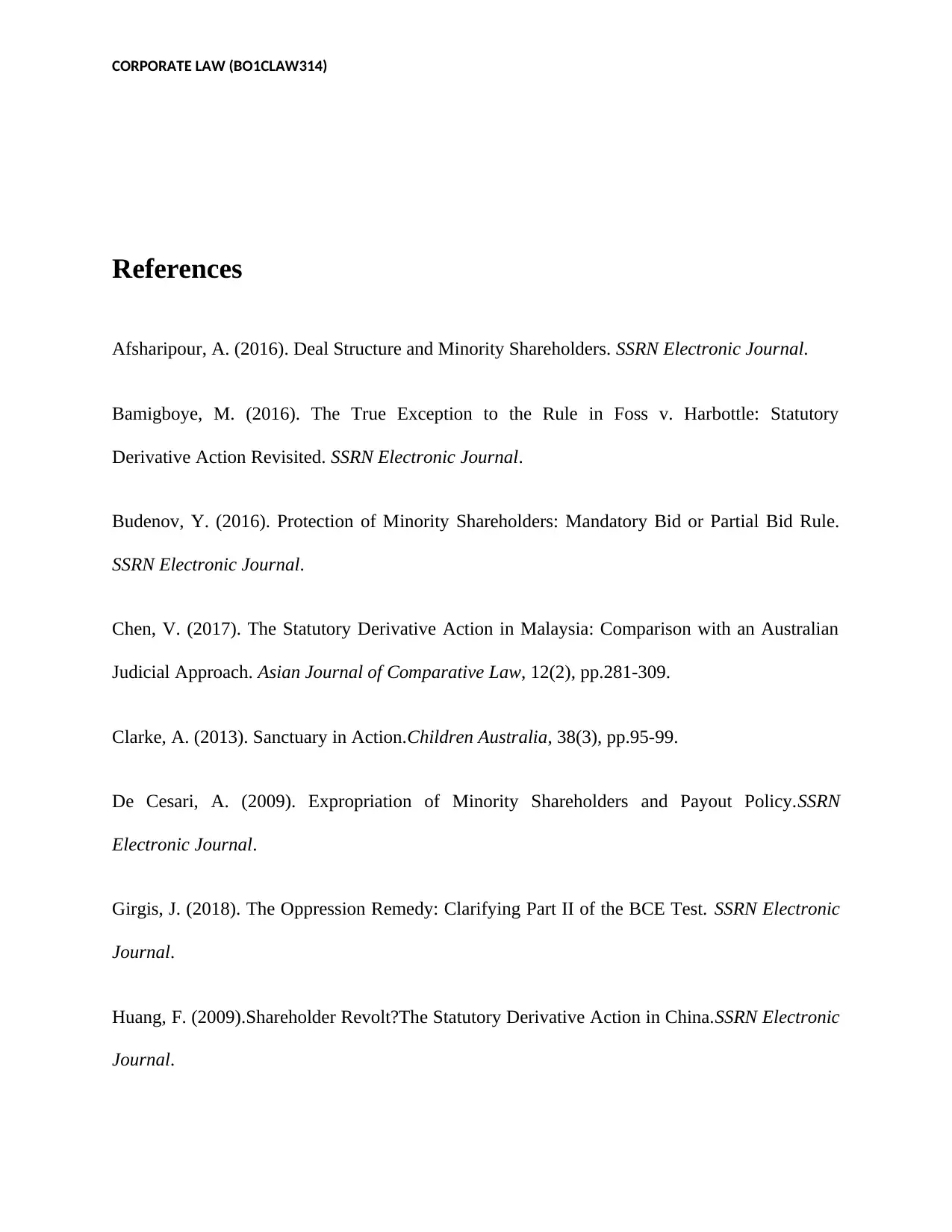
CORPORATE LAW (BO1CLAW314)
References
Afsharipour, A. (2016). Deal Structure and Minority Shareholders. SSRN Electronic Journal.
Bamigboye, M. (2016). The True Exception to the Rule in Foss v. Harbottle: Statutory
Derivative Action Revisited. SSRN Electronic Journal.
Budenov, Y. (2016). Protection of Minority Shareholders: Mandatory Bid or Partial Bid Rule.
SSRN Electronic Journal.
Chen, V. (2017). The Statutory Derivative Action in Malaysia: Comparison with an Australian
Judicial Approach. Asian Journal of Comparative Law, 12(2), pp.281-309.
Clarke, A. (2013). Sanctuary in Action.Children Australia, 38(3), pp.95-99.
De Cesari, A. (2009). Expropriation of Minority Shareholders and Payout Policy.SSRN
Electronic Journal.
Girgis, J. (2018). The Oppression Remedy: Clarifying Part II of the BCE Test. SSRN Electronic
Journal.
Huang, F. (2009).Shareholder Revolt?The Statutory Derivative Action in China.SSRN Electronic
Journal.
References
Afsharipour, A. (2016). Deal Structure and Minority Shareholders. SSRN Electronic Journal.
Bamigboye, M. (2016). The True Exception to the Rule in Foss v. Harbottle: Statutory
Derivative Action Revisited. SSRN Electronic Journal.
Budenov, Y. (2016). Protection of Minority Shareholders: Mandatory Bid or Partial Bid Rule.
SSRN Electronic Journal.
Chen, V. (2017). The Statutory Derivative Action in Malaysia: Comparison with an Australian
Judicial Approach. Asian Journal of Comparative Law, 12(2), pp.281-309.
Clarke, A. (2013). Sanctuary in Action.Children Australia, 38(3), pp.95-99.
De Cesari, A. (2009). Expropriation of Minority Shareholders and Payout Policy.SSRN
Electronic Journal.
Girgis, J. (2018). The Oppression Remedy: Clarifying Part II of the BCE Test. SSRN Electronic
Journal.
Huang, F. (2009).Shareholder Revolt?The Statutory Derivative Action in China.SSRN Electronic
Journal.
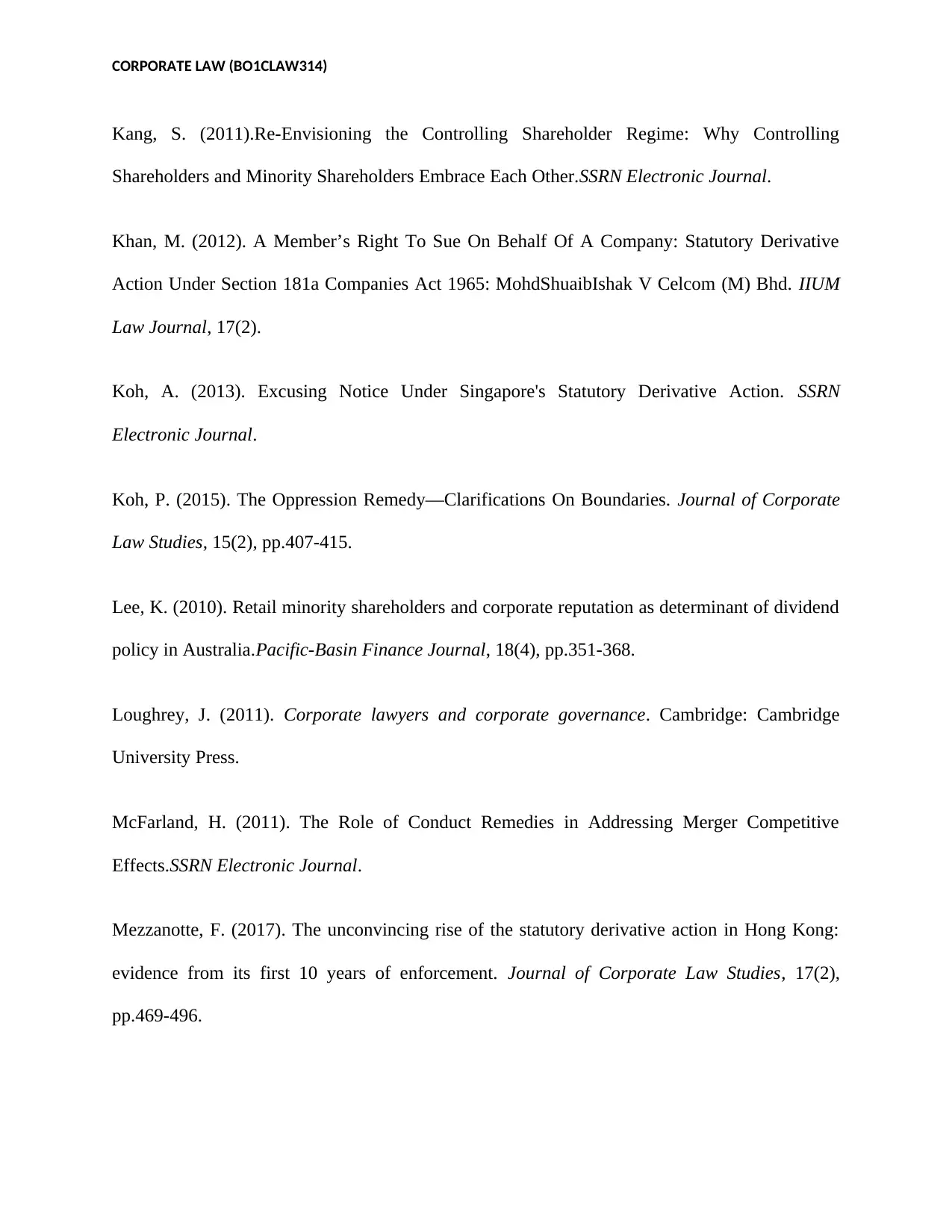
CORPORATE LAW (BO1CLAW314)
Kang, S. (2011).Re-Envisioning the Controlling Shareholder Regime: Why Controlling
Shareholders and Minority Shareholders Embrace Each Other.SSRN Electronic Journal.
Khan, M. (2012). A Member’s Right To Sue On Behalf Of A Company: Statutory Derivative
Action Under Section 181a Companies Act 1965: MohdShuaibIshak V Celcom (M) Bhd. IIUM
Law Journal, 17(2).
Koh, A. (2013). Excusing Notice Under Singapore's Statutory Derivative Action. SSRN
Electronic Journal.
Koh, P. (2015). The Oppression Remedy—Clarifications On Boundaries. Journal of Corporate
Law Studies, 15(2), pp.407-415.
Lee, K. (2010). Retail minority shareholders and corporate reputation as determinant of dividend
policy in Australia.Pacific-Basin Finance Journal, 18(4), pp.351-368.
Loughrey, J. (2011). Corporate lawyers and corporate governance. Cambridge: Cambridge
University Press.
McFarland, H. (2011). The Role of Conduct Remedies in Addressing Merger Competitive
Effects.SSRN Electronic Journal.
Mezzanotte, F. (2017). The unconvincing rise of the statutory derivative action in Hong Kong:
evidence from its first 10 years of enforcement. Journal of Corporate Law Studies, 17(2),
pp.469-496.
Kang, S. (2011).Re-Envisioning the Controlling Shareholder Regime: Why Controlling
Shareholders and Minority Shareholders Embrace Each Other.SSRN Electronic Journal.
Khan, M. (2012). A Member’s Right To Sue On Behalf Of A Company: Statutory Derivative
Action Under Section 181a Companies Act 1965: MohdShuaibIshak V Celcom (M) Bhd. IIUM
Law Journal, 17(2).
Koh, A. (2013). Excusing Notice Under Singapore's Statutory Derivative Action. SSRN
Electronic Journal.
Koh, P. (2015). The Oppression Remedy—Clarifications On Boundaries. Journal of Corporate
Law Studies, 15(2), pp.407-415.
Lee, K. (2010). Retail minority shareholders and corporate reputation as determinant of dividend
policy in Australia.Pacific-Basin Finance Journal, 18(4), pp.351-368.
Loughrey, J. (2011). Corporate lawyers and corporate governance. Cambridge: Cambridge
University Press.
McFarland, H. (2011). The Role of Conduct Remedies in Addressing Merger Competitive
Effects.SSRN Electronic Journal.
Mezzanotte, F. (2017). The unconvincing rise of the statutory derivative action in Hong Kong:
evidence from its first 10 years of enforcement. Journal of Corporate Law Studies, 17(2),
pp.469-496.
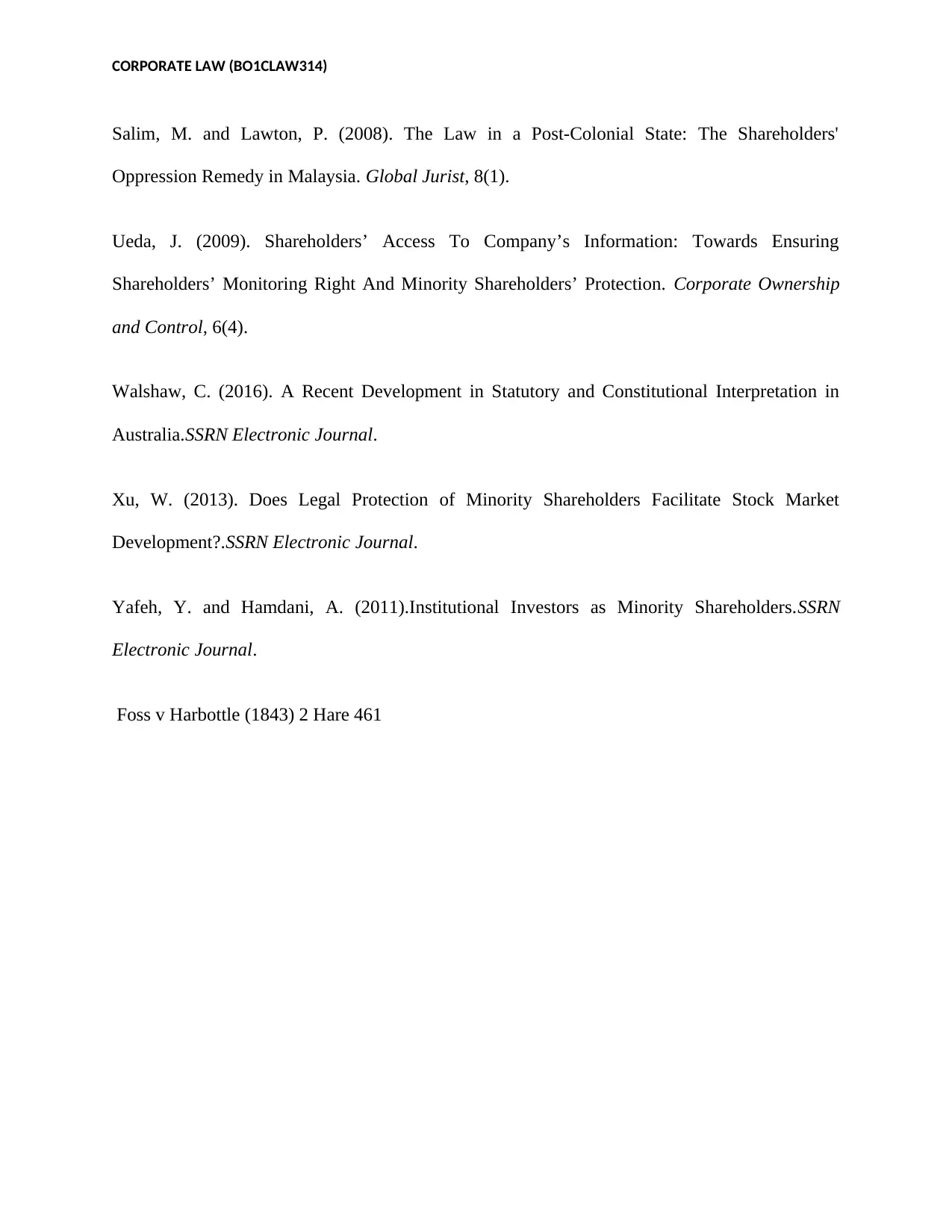
CORPORATE LAW (BO1CLAW314)
Salim, M. and Lawton, P. (2008). The Law in a Post-Colonial State: The Shareholders'
Oppression Remedy in Malaysia. Global Jurist, 8(1).
Ueda, J. (2009). Shareholders’ Access To Company’s Information: Towards Ensuring
Shareholders’ Monitoring Right And Minority Shareholders’ Protection. Corporate Ownership
and Control, 6(4).
Walshaw, C. (2016). A Recent Development in Statutory and Constitutional Interpretation in
Australia.SSRN Electronic Journal.
Xu, W. (2013). Does Legal Protection of Minority Shareholders Facilitate Stock Market
Development?.SSRN Electronic Journal.
Yafeh, Y. and Hamdani, A. (2011).Institutional Investors as Minority Shareholders.SSRN
Electronic Journal.
Foss v Harbottle (1843) 2 Hare 461
Salim, M. and Lawton, P. (2008). The Law in a Post-Colonial State: The Shareholders'
Oppression Remedy in Malaysia. Global Jurist, 8(1).
Ueda, J. (2009). Shareholders’ Access To Company’s Information: Towards Ensuring
Shareholders’ Monitoring Right And Minority Shareholders’ Protection. Corporate Ownership
and Control, 6(4).
Walshaw, C. (2016). A Recent Development in Statutory and Constitutional Interpretation in
Australia.SSRN Electronic Journal.
Xu, W. (2013). Does Legal Protection of Minority Shareholders Facilitate Stock Market
Development?.SSRN Electronic Journal.
Yafeh, Y. and Hamdani, A. (2011).Institutional Investors as Minority Shareholders.SSRN
Electronic Journal.
Foss v Harbottle (1843) 2 Hare 461
1 out of 10
Related Documents
Your All-in-One AI-Powered Toolkit for Academic Success.
+13062052269
info@desklib.com
Available 24*7 on WhatsApp / Email
![[object Object]](/_next/static/media/star-bottom.7253800d.svg)
Unlock your academic potential
© 2024 | Zucol Services PVT LTD | All rights reserved.





